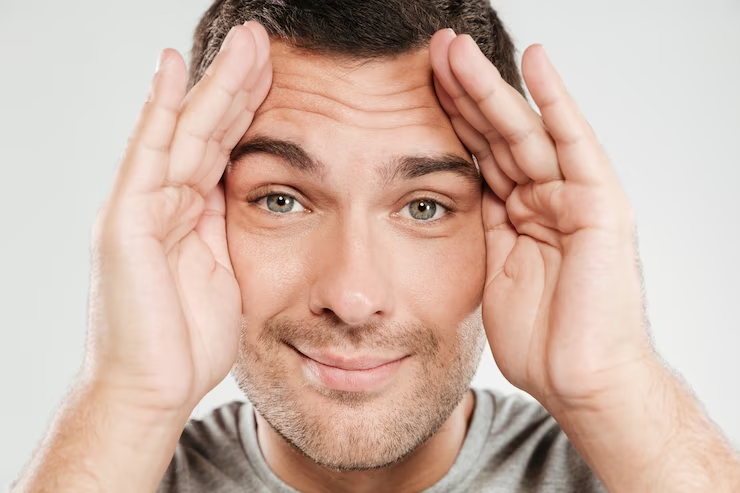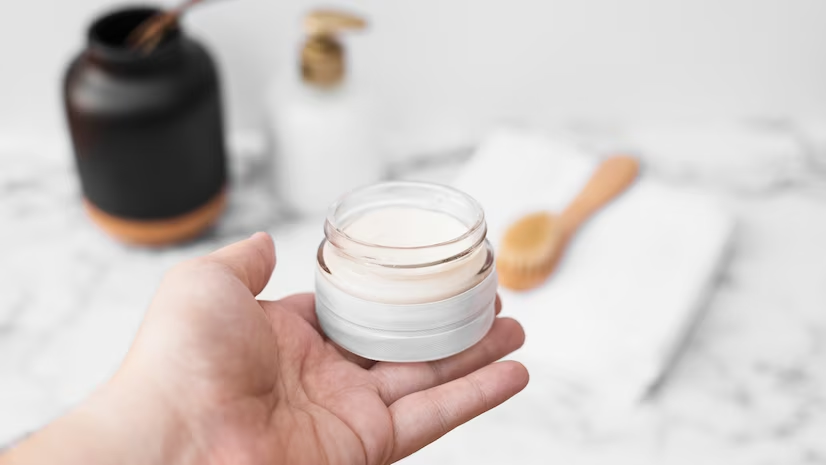
Have you ever caught a glimpse of yourself in the mirror, beaming with joy, only to notice the emergence of delicate lines underneath your eyes? It's a common concern for many individuals who notice the appearance of eye wrinkles when smiling. These subtle yet noticeable creases can become a source of self-consciousness and prompt questions about their causes, prevention, and treatment options.
In this blog post, we delve into the fascinating world of wrinkles under eyes when smiling, uncovering the science behind their formation and providing insights on embracing and caring for our natural beauty.
What Are Wrinkles?
Wrinkles are visible lines and creases on the skin's surface due to various factors, including aging, facial expressions, and environmental influences. Wrinkles are a natural part of aging, most prominently seen in sun exposed sites. Severity of aging signs such as wrinkles and fine lines depends on your genetic tendency, skin type and exposure to environmental toxins. They can occur on different body parts such as face, neck, hands and forearms, but we will focus on wrinkles under the eyes when smiling for this blog post.
Types of Wrinkles

Dynamic Wrinkles
Dynamic wrinkles are the wrinkles that form as a result of repeated facial muscle movements and expressions. These wrinkles are temporary and appear when the muscles contract. For example, when you smile, laugh, frown, or squint, dynamic wrinkles may appear around the eyes, forehead, or mouth. They are typically more noticeable during active facial expressions and tend to fade when the muscles rest.
Static Wrinkles
Static wrinkles are visible even when the face is at rest. These wrinkles develop due to natural aging, decreased skin elasticity, and the cumulative effects of sun exposure, environmental factors, and lifestyle habits. Unlike dynamic wrinkles, static wrinkles are present regardless of facial expressions. They can be deeper and more pronounced, often as fine lines, creases, or folds. Common areas for static wrinkles include the forehead, cheeks, and under the eyes.
Eventually dynamic lines become static when:
Smiling and activity of eyelid muscles lead to crows feet around eyes
Raising eyebrows contract the forehead muscle, leading to worry lines on forehead.
When you are angry or deeply concentrating, frown lines appear between your eyebrows due to contraction of those muscles.
Sometimes these wrinkles tend to be asymmetrical, depending on the side of cheek you sleep on and the side you use more to laugh, smile or frown.
Wrinkle Folds
Wrinkle folds are deeper and more prominent wrinkles due to a combination of factors, including skin elasticity, collagen, and fat volume loss. These folds result in a more pronounced skin sagging or drooping appearance. Nasolabial folds (smile lines) and marionette lines (extending from the corners of the mouth to the chin) are wrinkle folds. They can contribute to an aged or tired appearance, particularly when combined with other wrinkles.
Sags and bags occur due to skin laxity or drooping. They occur due to reduction of fat cells under the skin, loss of collagen and elastin fibers. Gravity causes lax tissue to sag.
Fine lines and wrinkles arise because of irregular thickening of the dermis (deep part of skin containing collagen, blood vessels, hair follicles and glands) and reduction in the amount of water held in the epidermis (outer epithelial layer of skin). These happen mainly due to sun damage and exposure to environmental toxins.
Factors Contributing to Wrinkles Under The Eyes When Smiling

Several factors contribute to the development of wrinkles under the eyes when smiling. Understanding these factors can help individuals take preventive measures and make informed choices for their skincare routines. Here are some key factors:
Age-related Changes
As we age, our skin undergoes natural changes that contribute to the formation of wrinkles. The production of collagen and elastin, proteins responsible for maintaining skin elasticity and firmness, decreases over time. This leads to the thinning and weakening of the skin, making it more susceptible to wrinkling, especially under the eyes when smiling.
Repetitive Facial Movements
The repeated contraction of facial muscles during smiling, laughing, squinting, or other facial expressions can contribute to the developing wrinkles under the eyes. Over time, these repetitive movements create creases in the skin, especially in areas where the skin is thinner, such as around the eyes.
Reduced Skin Elasticity
The skin's elasticity plays a crucial role in resisting the formation of wrinkles. However, our skin loses its natural elasticity as we age, making it less capable of bouncing back from repeated stretching or muscle contractions. This diminished elasticity can contribute to the appearance of wrinkles under the eyes when smiling.
Sun Exposure
Exposure to ultraviolet (UV) rays from the sun is a major contributor to premature aging and the development of wrinkles. UV radiation damages the collagen and elastin fibers in the skin, leading to their breakdown and the subsequent formation of wrinkles. The delicate skin under the eyes is particularly vulnerable to sun damage, making it more prone to wrinkling when smiling. Although sun damage contributes mostly to wrinkles, this is a preventable cause.
Smoking
Smoking is known to accelerate the aging process and contribute to the development of wrinkles. The chemicals in tobacco smoke constrict blood vessels, reducing blood flow and oxygen supply to the skin. This deprives the skin of essential nutrients, leading to decreased collagen production and increased breakdown of elastin (which are supporting proteins of skin tissue), resulting in wrinkles, including under the eyes.
Dehydration
Inadequate hydration can negatively impact the skin's health and contribute to the formation of wrinkles. When the skin lacks proper hydration, it becomes less plump and resilient, making wrinkles more apparent, including under the eyes when smiling. Maintaining optimal hydration by drinking adequate water is crucial for healthy-looking skin.
Skin tension, gravity, injury and surgery to skin around eyes, skin diseases which cause scarring like discoid lupus erythematosus also contribute to wrinkles around eyes.
Preventing Wrinkles Under Eyes When Smiling

Preventing wrinkles under eyes when smiling involves adopting a proactive approach to skincare and making lifestyle adjustments. By implementing the following preventive measures, you can help minimize the appearance of wrinkles and maintain a youthful look:
Moisturize the Delicate Eye Area:
Use a gentle, hydrating eye cream or serum to keep the skin around your eyes well-hydrated. Look for products containing ingredients like hyaluronic acid, which helps retain moisture and plump the skin.Prescription strength anti wrinkle creams contain retinoids (a derivative of vitamin A) which reduces fine lines, pigmentation and rough skin. Retinol is a less powerful Vitamin A derivative that can be bought over the counter. The prescription retinoids are much better in reducing wrinkles and preventing new wrinkles from forming.
Use a high quality moisturizer twice a day after washing your face with a non soap cleanser and lukewarm water. Avoid moisturizers that contain scents, glitter, dyes or a lot of preservatives which can irritate your skin.
Anti-aging ingredients include:
Topical retinoids
Vitamin C
Vitamin E
Alpha hydroxy acids
Polypeptides
Use a moisturizer designed for face, as body moiturizers do not work well on facial skin.
Protect Against Sun Damage
: Apply sunscreen with a high SPF specifically formulated for the delicate skin around the eyes. If your moisturizer contains SPF, you don't need to apply sunscreen additionally. UV rays can accelerate the aging process and contribute to wrinkle formation. Wear sunglasses with UV protection to shield your eyes and the surrounding skin from harmful sun exposure.Maintain a Healthy Lifestyle:
A balanced diet of antioxidants, vitamins, and minerals can promote overall skin health. Add foods like fruits, vegetables, lean proteins, and healthy fats to your meals. Avoid excessive sugar and processed foods, which can contribute to skin damage and premature aging.Stay Hydrated
: Drink adequate water throughout the day to keep your body and skin hydrated. Proper hydration helps maintain skin elasticity and plumpness, reducing the visibility of wrinkles.Avoid Smoking:
Smoking accelerates the aging process and damages collagen and elastin fibers, leading to the formation of wrinkles. Quitting smoking or avoiding exposure to secondhand smoke can help preserve your skin's youthful appearance, including the under-eye area.Protect Your Eyes with Sunglasses
: When exposed to bright sunlight, we tend to squint, which can contribute to the development of wrinkles. Wear sunglasses that provide UV protection to shield your eyes from harsh sunlight and minimize the need to squint.Practice Facial Exercises
: Engage in facial exercises targeting the eye muscles. These exercises can help strengthen the muscles and improve blood circulation, promoting skin elasticity and reducing the appearance of wrinkles.Get Sufficient Sleep:
A good night's sleep is essential for overall skin health. Lack of sleep can lead to increased stress, which can accelerate the aging process and contribute to the formation of wrinkles. Aim for 7-8 hours of quality sleep each night.Treating Wrinkles Under Eyes when Smiling

Treating under eye wrinkles when smiling involves various options that can help minimize their appearance and restore a youthful look. Here are some effective treatments to consider:
Topical Retinoids
Retinoids, derived from vitamin A, are known for their ability to stimulate collagen production and promote cell turnover. Applying a retinoid cream or serum specifically formulated for the under-eye area can help reduce the appearance of wrinkles when smiling over time. Look for products with ingredients like retinol or retinaldehyde, and follow the instructions carefully to avoid irritation.
Hyaluronic Acid Fillers
Hyaluronic acid (HA) fillers, such as Restylane or Juvederm, can be injected into the under-eye area to add volume and fill wrinkles. These fillers work by plumping up the skin and reducing the appearance of fine lines and wrinkles when smiling. The results are typically immediate but temporary and may last from several months to a year.
Botox Injections
Botulinum toxin type A, commonly known as Botox, can be used to relax the muscles responsible for the formation of wrinkles when smiling. By injecting small amounts of Botox into specific areas, muscle contractions are temporarily reduced, leading to a smoother appearance. It is done mainly for dynamic lines to paralyze muscles that are responsible for creating crows feet, frown lines and forehead lines. Botox treatments for under eye wrinkles when smiling are typically performed by experienced professionals and can last around three to four months.
Laser Resurfacing
Laser resurfacing treatments use laser technology to remove damaged skin layers and stimulate collagen production. Fractional laser resurfacing, particularly, can target under eye wrinkles when smiling by promoting the growth of new, healthier skin cells. This treatment can require multiple sessions, and downtime may be involved, but the results can significantly reduce the appearance of wrinkles. Other LASER treatments include Non-ablative LASER, and carbon dioxide LASER resurfacing.
Chemical Peels
Chemical peels involve applying a chemical solution (Glycolic acid, trichloro acetic acid, etc) to the skin to exfoliate the outer layers. This process encourages the growth of new skin cells, improves skin texture, and reduces the visibility of under eye wrinkles when smiling. The intensity of the peel can be adjusted based on your needs, and recovery time may vary depending on the depth of the peel.
Microneedling
Microneedling, or collagen induction therapy, involves using a device with tiny needles to create controlled micro-injuries in the skin. This process stimulates collagen production and can help improve the appearance of under eye wrinkles when smiling. Skincare professionals typically perform microneedling treatments and may require multiple sessions for optimal results.
Microdermabrasion
Microdermabrasion and dermabrasion are also done by professionals to reduce wrinkles and fine lines. Lines and furrows can be lifted up with implants (grafts or permanent or temporary fillers).
Cosmetic facial surgery
This involves repositioning of facial tissues and altering the structure of sagging tissues. Ex: face lift, brow lift
There are no permanent solutions for wrinkles. All these procedures have potential side effects.
Natural Remedies and Home Treatments

In addition to professional treatments, several natural remedies and home treatments can complement your efforts in reducing under eye wrinkles when smiling. While these remedies may not provide drastic results like medical procedures, they can help nourish and improve the overall health of your skin. Here are some natural remedies to consider:
Moisturize with Natural Oils
Apply natural oils like almond, coconut, or avocado oil to the under-eye area. These oils are rich in antioxidants and healthy fatty acids that can help hydrate and nourish the skin, reducing the appearance of under eye wrinkles when smiling. Gently massage the oil into the skin using circular motions before bedtime.
Cucumber Slices
Place chilled cucumber slices over your closed eyes and relax for 10-15 minutes. Cucumbers have a soothing and cooling effect on the skin, helping to reduce puffiness and temporarily tighten the under-eye area. Regular use can give a refreshed and rejuvenated appearance, diminishing the appearance of wrinkles when smiling.
Cold Compresses
Apply a cold compress or chilled green tea bags to the under-eye area for a few minutes. The cold temperature can help constrict blood vessels, reduce swelling, and temporarily tighten the skin, making under-eye wrinkles less visible when smiling.
Homemade Eye Masks
Create a DIY eye mask by combining natural ingredients like aloe vera gel, honey, and a small rosehip seed oil. Apply the mixture to the under-eye area and leave it on for 15-20 minutes before gently rinsing off. These ingredients contain antioxidants and nourishing properties that can promote skin elasticity and minimize the appearance of under eye wrinkles when smiling.
Stay Hydrated and Follow a Healthy Diet
Drink plenty of water to keep your body and skin hydrated. Hydration is essential for maintaining skin elasticity and reducing the visibility of wrinkles. Additionally, consume a diet rich in fruits, vegetables, lean proteins, and healthy fats to provide your skin with essential nutrients and support its overall health.
Facial Exercises
Practice facial exercises that target the muscles around the eyes. These exercises can help strengthen the muscles, improve circulation, and promote collagen production, which can contribute to reducing under eye wrinkles when smiling. For example, gently press your fingertips under the eyes and squint, then release and repeat several times.
Conclusion
Wrinkles under eyes when smiling can be a natural part of the aging process, but there are ways to minimize their appearance and maintain a youthful look. Understanding the types of wrinkles, such as dynamic wrinkles, static wrinkles, and wrinkle folds, helps develop an effective approach to prevention and treatment.


